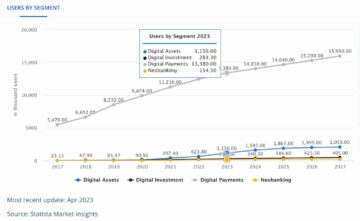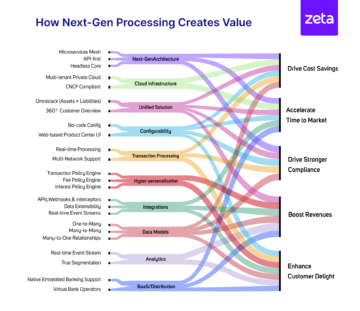
If you want to understand why something has gone wrong in a financial organization, the best person to start with is most typically the Chief Risk Officer (CRO).
A CRO plays a critical role as an organization’s guardian angel to foster and prioritise a risk-aware culture that promotes resilience and adaptability alongside safeguarding long-term business success.
But it is certainly not an easy role. The taxonomy of risks that CROs are now responsible for managing has grown at an eye-watering pace in recent years and the environment banks are lending into today is acutely high-risk. To be effective in their role, CROs must be armed with more digitally enabled defence frameworks that provide a holistic and clear view of risk based on trusted data.
The stormy environment of risk
With the economy still under strain globally, businesses are in a battle to recover from the supply and demand shocks we witnessed during the pandemic. In fact, according to data from EY, in
2020, we saw the highest level of lending reported in 13 years.
And in a race to win market share and contend with potential disintermediation from new market entrants, many major banks are in accelerated growth mode. They are taking far more risk onto their balance sheets and actively recruiting customers in verticals they do not previously have experience with. The interactions are more frequently online with far fewer physical meetings.
Relationship Managers have now evolved into Portfolio Managers who look after 200 relationships where they used to cover 20. The convergence of these factors means those Relationship Managers no longer command a deep understanding of their customers and can no longer be relied upon to spot the red flags or the early warning signs of delinquency, default, or fraud.
Unfortunately, all too often this scenario can manifest in poor quality credit decisions, misclassifications of clients, incorrect capital allocation, mishandled portfolios, reputation-damaging scandals, or waning customer trust.
Building resilience with new approaches
But there is some good news – whether it’s Large Language Models, Natural Language Processing, Deep Learning Models or Decision Intelligence, there is no shortage of innovations emerging to help manage these risks.
Graph Analytics is one of the more powerful technologies that is increasingly adopted in this domain. There are an increasing number of corporate failures (large and small) where the counterparties a customer transacts with is one of the most important tell-tale factors in understanding the true credit and fraud risks. The existing credit models may assess the customer’s financial health directly as being low risk, but if their key customers or suppliers are under pressure (or worse they are phony shell companies used to create the illusion of normal trading) things can quickly unravel.
So why don’t credit models just analyse counterparties today? There have been two key (now solvable) problems:
1) When those counterparties are not also customers the available information about them is very thin.
Solution: by combining Graph Analytics with
Entity Resolution that thin information can be enriched with other data sources supporting a far greater understanding of those non-customer counterparties to a level that makes that analysis possible.
2) Counterparties are not static – they change over time.
Solution: risk monitoring can be implemented on a perpetual basis rather than being performed at point of onboarding and periodically so the degradation in the quality of counterparties can be tracked and the risks can be identified at the point they manifest.
Another new area of innovation is the integration of digital channel data into the monitoring process. By combining the behaviours observed in the digital channel with the wider customer information, the customers transactions, as well as external data like the corporate registry information or credit bureau data, a far more holistic understanding of the risk is achieved.
The adoption of this type of analysis can make a difference to the tune of billions of dollars of exposures being better managed and potential defaults being detected up to 18 months earlier. It serves as an early warning system (think, check engine light) allowing organizations to identify and address potential risks before they manifest into significant issues.
Charting the course
Think of a CRO as guiding an organization through unexpected storms, armed with many years of experience, ready to tackle any crises that come their way. But just like a captain of a ship needs a sextant and charts to help guide decision making in inclement conditions, CROs need systems and technology to identify risk and chart a course through troubled water.
As we witness unprecedented uncertainty levels, with factors like geopolitical tensions and economic volatility rocking the boat, CROs are gripping their life vests tightly and preparing for the unexpected. Those who have invested in the right equipment are best placed to weather the storm.
- SEO Powered Content & PR Distribution. Get Amplified Today.
- PlatoData.Network Vertical Generative Ai. Empower Yourself. Access Here.
- PlatoAiStream. Web3 Intelligence. Knowledge Amplified. Access Here.
- PlatoESG. Automotive / EVs, Carbon, CleanTech, Energy, Environment, Solar, Waste Management. Access Here.
- BlockOffsets. Modernizing Environmental Offset Ownership. Access Here.
- Source: https://www.finextra.com/blogposting/24723/weathering-the-storm-the-crucial-role-of-a-chief-risk-officer?utm_medium=rssfinextra&utm_source=finextrablogs
- :has
- :is
- :not
- :where
- $UP
- 13
- 20
- 200
- a
- About
- accelerated
- According
- achieved
- actively
- adaptability
- address
- adopted
- Adoption
- After
- All
- allocation
- Allowing
- alongside
- also
- an
- analyse
- analysis
- analytics
- and
- Angel
- any
- ARE
- AREA
- armed
- AS
- assess
- At
- available
- Balance
- balance sheets
- Banks
- based
- basis
- Battle
- BE
- been
- before
- behaviours
- being
- BEST
- Better
- billions
- boat
- Bureau
- business
- businesses
- but
- by
- CAN
- capital
- certainly
- change
- Channel
- Chart
- Charts
- check
- chief
- clear
- clients
- combining
- come
- Companies
- conditions
- Convergence
- Corporate
- counterparties
- course
- cover
- create
- credit
- crises
- critical
- CRO
- crucial
- Culture
- customer
- customer information
- Customers
- data
- decision
- Decision Making
- decisions
- deep
- deep learning
- Default
- defaults
- defence
- Demand
- detected
- difference
- digital
- digitally
- directly
- do
- dollars
- domain
- Dont
- during
- Earlier
- Early
- easy
- Economic
- economic volatility
- economy
- Effective
- emerging
- enabled
- Engine
- enriched
- entity
- entrants
- Environment
- equipment
- evolved
- existing
- experience
- external
- EY
- fact
- factors
- far
- fewer
- financial
- financial health
- Finextra
- flags
- For
- Foster
- frameworks
- fraud
- frequently
- from
- geopolitical
- Globally
- gone
- good
- graph
- greater
- grown
- Growth
- guardian
- guide
- Have
- Health
- help
- high-risk
- highest
- holistic
- HTTPS
- identified
- identify
- if
- Illusion
- implemented
- important
- in
- increasing
- increasingly
- information
- Innovation
- innovations
- integration
- Intelligence
- interactions
- into
- invested
- issues
- IT
- jpg
- just
- Key
- language
- large
- learning
- lending
- Level
- levels
- Life
- light
- like
- long-term
- longer
- Look
- Low
- major
- make
- MAKES
- Making
- manage
- managed
- Managers
- managing
- many
- Market
- market share
- May..
- means
- meetings
- Mode
- models
- monitoring
- months
- more
- most
- must
- Natural
- Natural Language
- Natural Language Processing
- Need
- needs
- New
- New Market
- news
- no
- normal
- now
- number
- observed
- of
- Officer
- often
- on
- Onboarding
- ONE
- online
- onto
- or
- organization
- organizations
- Other
- over
- Pace
- pandemic
- performed
- Perpetual
- person
- phony
- physical
- plato
- Plato Data Intelligence
- PlatoData
- plays
- Point
- poor
- portfolio
- portfolio managers
- portfolios
- possible
- potential
- powerful
- preparing
- pressure
- previously
- prioritise
- problems
- process
- processing
- promotes
- provide
- quality
- quickly
- Race
- rather
- ready
- recent
- Recover
- recruiting
- Red
- Red Flags
- registry
- relationship
- Relationships
- Reported
- resilience
- responsible
- right
- Risk
- risks
- Role
- safeguarding
- saw
- scandals
- scenario
- serves
- Share
- Shell
- shortage
- significant
- Signs
- small
- So
- some
- something
- Sources
- Spot
- start
- Still
- Storm
- storms
- success
- suppliers
- supply
- Supply and Demand
- Supporting
- system
- Systems
- tackle
- taking
- taxonomy
- Technologies
- Technology
- tensions
- than
- that
- The
- their
- Them
- There.
- These
- they
- things
- Think
- this
- those
- Through
- tightly
- time
- to
- today
- too
- Trading
- Transactions
- true
- Trust
- trusted
- two
- type
- typically
- Uncertainty
- under
- understand
- understanding
- Unexpected
- unprecedented
- unravel
- upon
- used
- verticals
- very
- View
- Volatility
- want
- warning
- Water
- Way..
- we
- Weather
- WELL
- when
- whether
- WHO
- why
- wider
- win
- with
- witness
- witnessed
- worse
- Wrong
- years
- you
- zephyrnet










